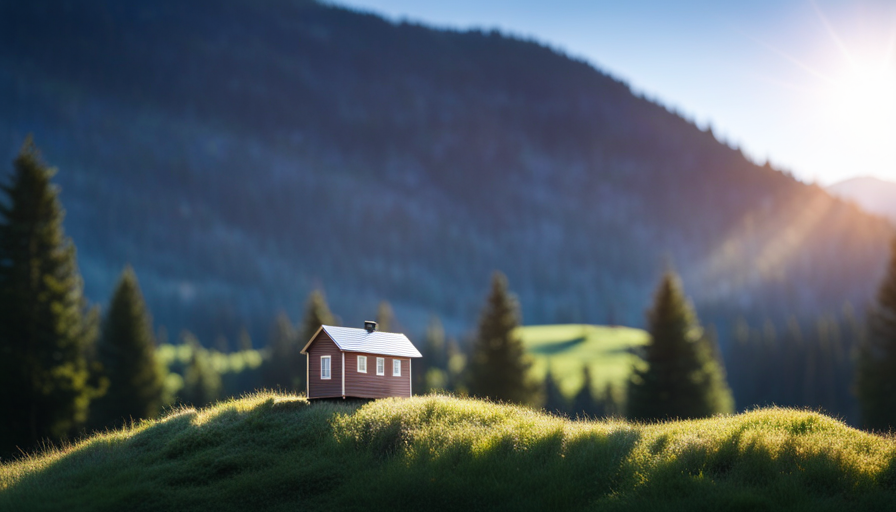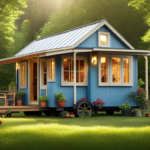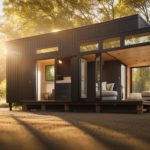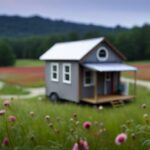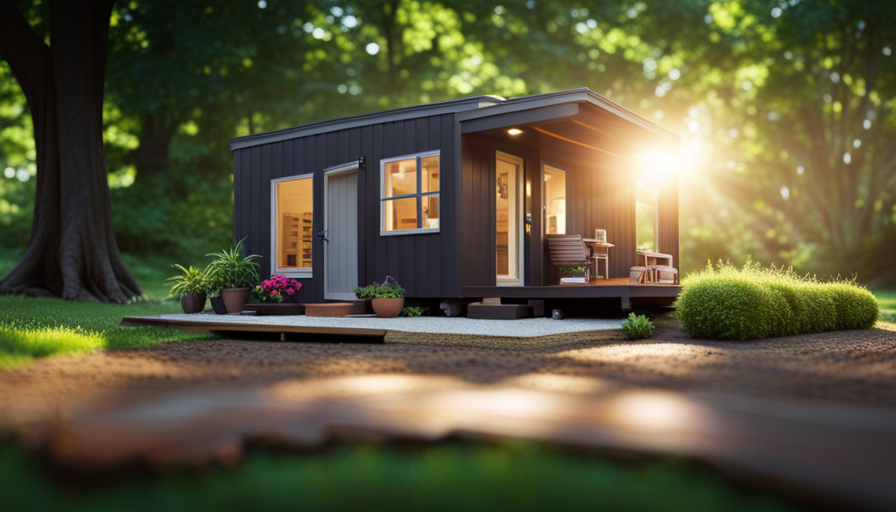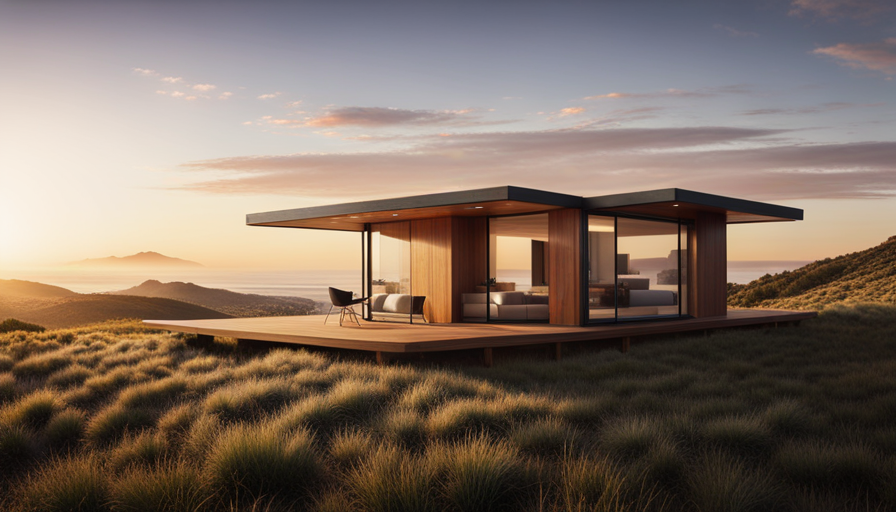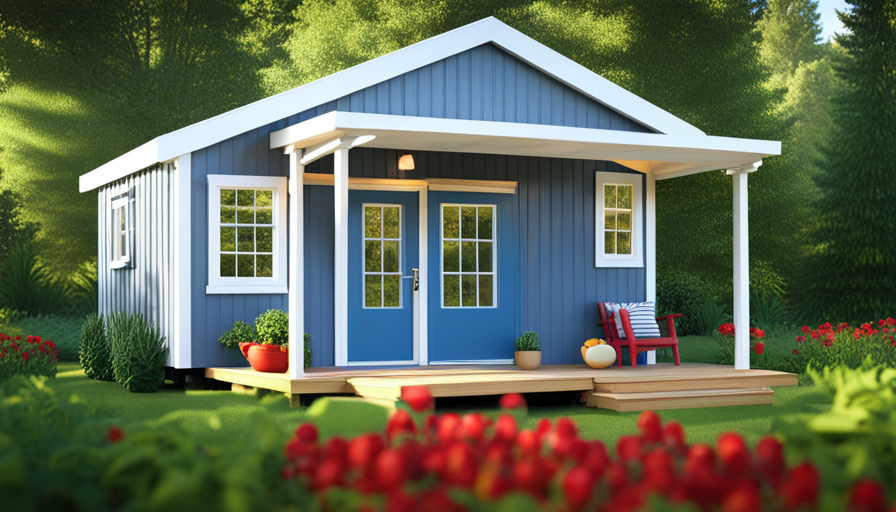Have you ever fantasized about residing in a snug, small area that precisely fits your requirements? A tiny house could be the solution you’ve been searching for. However, before you commence this thrilling adventure, it’s crucial to thoroughly comprehend the financial commitment required to construct your ideal tiny home.
In this article, I will guide you through the process of determining your budget, researching building materials, considering the size and layout, and factoring in labor costs. I will also explore financing options, long-term costs, and maintenance considerations. To ensure success, consulting with professionals and experienced tiny house builders is essential. Additionally, planning for unexpected expenses and maintaining flexibility in your budget is crucial.
So, let’s dive into the detailed world of building a tiny house and discover how to make your dream a reality.
Key Takeaways
- It is crucial to determine budget and goals before starting the building process of a tiny house.
- Researching different financing options and comparing building materials and costs are important for cost-effective choices.
- Carefully planning the size and layout of the tiny house can optimize space and balance comfort with unnecessary square footage.
- Consulting with professionals and experienced builders is essential for a successful construction project, as they can offer valuable advice on design, materials, and construction techniques.
Determine Your Budget and Goals
You need to figure out your budget and goals so that you can make your tiny house dreams a reality. Determining your budget is crucial because it’ll dictate the size, design, and materials you can use for your tiny house.
Start by evaluating your current financial situation and determining how much you can afford to spend on building your tiny house. Consider your income, savings, and any potential financing options. There are various budgeting strategies you can employ, such as setting aside a certain percentage of your income each month or cutting back on unnecessary expenses.
Additionally, research different financing options available to you, such as personal loans or RV loans specifically designed for tiny house construction.
Once you have a clear budget in mind, you can establish your goals for your tiny house. What are your priorities? Are you looking for a minimalist lifestyle, or do you need more space for a growing family? Do you want to live off-grid or have access to all the modern amenities? Defining your goals will help you make informed decisions throughout the building process.
Researching and comparing building materials and costs is the next step in making your tiny house a reality.
Research and Compare Building Materials and Costs
Comparing different materials and their respective costs can significantly impact the overall expenses of constructing a compact dwelling. When it comes to building a tiny house, it’s crucial to research and compare building materials to ensure you make the most cost-effective choices.
Here is a breakdown of the building materials comparison and cost analysis:
-
Exterior Materials:
- Wood: It’s a popular choice due to its versatility and affordability. However, it requires regular maintenance to prevent rot and decay.
- Metal: It offers durability and is resistant to fire and pests. However, it can be more expensive than wood.
-
Insulation Materials:
- Spray Foam Insulation: It provides excellent insulation and helps reduce energy costs. However, it can be more costly upfront compared to traditional insulation materials.
- Fiberglass Insulation: It’s a budget-friendly option but may not provide the same level of insulation as spray foam.
Considering the size and layout of your tiny house, you can choose the most suitable materials based on your budget and goals. By carefully analyzing the costs and benefits of different building materials, you can make informed decisions that’ll impact the overall expenses of your tiny house project.
Consider the Size and Layout of Your Tiny House
Taking into account the dimensions and arrangement of my compact dwelling, it’s essential to carefully consider the size and layout to ensure optimal use of space.
When it comes to size considerations, it’s important to strike a balance between having enough space to live comfortably and not going overboard with unnecessary square footage. This involves evaluating my lifestyle and needs, as well as researching common dimensions for tiny houses to get an idea of what works best for others.
Layout planning is another crucial aspect to consider. I need to think about how I’ll utilize each area of my tiny house efficiently. This includes determining the placement of essential features such as the kitchen, bathroom, and sleeping area, as well as considering the flow and accessibility within the space. I may want to incorporate space-saving solutions like built-in storage and multifunctional furniture to maximize the use of every inch.
By carefully analyzing the size and layout of my tiny house, I can ensure that it meets my specific needs and preferences. This won’t only enhance my daily living experience but also impact the overall cost of construction.
Moving forward, it’s important to factor in labor costs and DIY options to further explore the financial aspects of building a tiny house.
Factor in Labor Costs and DIY Options
Consider the artisans and their expertise, for their labor costs and the possibility of DIY options can greatly influence the financial aspects of your dream abode. When it comes to building a tiny house, labor costs can vary depending on the complexity of the design and the expertise of the craftsmen involved. Hiring skilled professionals may be more expensive but can ensure a high-quality and well-built structure. On the other hand, opting for a DIY approach can save you money, but it requires a significant amount of time, effort, and knowledge in construction.
To further explore your options, here are some cost-saving options to consider:
-
Utilize salvaged or recycled materials: Incorporating reclaimed materials into your tiny house can not only save you money, but also add character and uniqueness to your home.
-
Trade skills with others: Consider bartering or exchanging services with others who have the skills you need. This can help reduce labor costs and create a sense of community.
-
Join a tiny house building workshop: Participating in a workshop can provide valuable hands-on experience and guidance from experts, while also saving on labor costs.
-
Use pre-designed plans: Purchasing pre-designed plans can be a cost-effective option as it eliminates the need for custom designs, which can be expensive.
-
Do some of the work yourself: By tackling certain tasks, such as painting or interior decorating, you can save on labor costs.
Considering these labor and cost-saving options can help you make informed decisions when it comes to building your tiny house.
Now, let’s explore how to choose the right location for your dream abode.
Choose the Right Location for Your Tiny House
Finding the perfect spot to plant your dream abode is like discovering a hidden gem in a vast sea of possibilities. When it comes to choosing the right location for your tiny house, there are a few key factors to consider.
One of the most important aspects is understanding the zoning regulations in your area. Different cities and towns have different rules and restrictions when it comes to tiny houses, so it’s crucial to do your research and make sure your dream home will be allowed in the chosen location.
In addition to zoning, finding the perfect tiny house community can greatly enhance your living experience. These communities are specifically designed for tiny house living and often provide amenities such as communal spaces, shared gardens, and even organized events. Being surrounded by like-minded individuals who appreciate the simplicity and minimalism of tiny house living can create a strong sense of community and support.
As you start to narrow down your options and choose a location, it’s important to keep in mind that additional expenses such as permits and utilities will need to be factored into your budget. These costs can vary depending on the location and specific requirements of your tiny house. Transitioning into the next section about calculating these expenses, it’s crucial to have a clear understanding of the financial implications of your chosen location.
Calculate Additional Expenses such as Permits and Utilities
Once you’ve unearthed the hidden treasure of your ideal tiny house location, be prepared to uncover the buried costs of permits and utilities that lie beneath the surface. Calculating expenses for permits and utilities is a crucial step in determining the total cost of building your tiny house. Here are three important factors to consider:
-
Permit costs: Research the specific requirements and fees for permits in your chosen location. Some areas have strict regulations and may charge higher fees for building permits. It’s important to factor in these costs when budgeting for your tiny house project.
-
Utility connections: Determine the costs of connecting your tiny house to utilities such as water, electricity, and sewage. This may involve hiring professionals to install connections or obtaining permits for utility hookups. These expenses can vary depending on the location and accessibility of utilities.
-
Off-grid options: If you’re considering an off-grid tiny house, you’ll need to calculate the expenses of alternative energy sources, such as solar panels or composting toilets. These sustainable options may require upfront investments but can save you money in the long run.
Once you have a clear understanding of these additional expenses, you can explore financing options and budgeting strategies to ensure your tiny house project stays within your financial means.
Explore Financing Options and Budgeting Strategies
To ensure your dream of owning a small, affordable dwelling becomes a reality, you should explore various financing options and implement effective budgeting strategies.
When it comes to financing options, there are several routes you can take. One option is to secure a traditional mortgage specifically designed for tiny houses. These mortgages often require a larger down payment and have shorter repayment terms compared to traditional home loans. Another option is to consider personal loans or lines of credit from banks or credit unions. These can provide you with the necessary funds to build your tiny house, but keep in mind that they may come with higher interest rates. Additionally, crowdfunding platforms have become popular for financing tiny house projects, allowing individuals to raise money from a community of supporters.
In terms of budgeting strategies, it’s important to have a clear understanding of your financial situation and set realistic goals. Start by creating a detailed budget that includes all the costs associated with building and maintaining your tiny house, such as materials, labor, permits, and utilities. Consider ways to cut costs, such as purchasing reclaimed materials or doing some of the work yourself. It’s also helpful to establish an emergency fund for unexpected expenses that may arise during the construction process.
By exploring financing options and implementing effective budgeting strategies, you can ensure that your dream of owning a tiny house becomes a reality.
Now, let’s consider the long-term costs and maintenance of a tiny house.
Consider the Long-Term Costs and Maintenance of a Tiny House
Considering the long-term expenses and upkeep of a small dwelling, it’s important to note that the average annual maintenance cost for tiny houses is approximately $2,000, which can add up significantly over time.
To ensure long-term sustainability and energy efficiency, there are several key factors to consider:
-
Energy-efficient appliances: Investing in energy-efficient appliances can help reduce long-term energy costs. Look for appliances with high energy efficiency ratings, such as ENERGY STAR certified models, which can significantly lower your utility bills.
-
Sustainable materials: Choosing sustainable materials for your tiny house can have a positive impact on both the environment and your wallet. Opt for materials that are durable, low-maintenance, and made from renewable resources.
-
Off-grid options: Incorporating off-grid systems, such as solar panels or rainwater harvesting, can further reduce long-term costs. These systems can help you become more self-sufficient and decrease your dependence on traditional utilities.
Considering these factors can help you make informed decisions about the long-term costs and maintenance of your tiny house. By prioritizing long-term sustainability and energy efficiency, you can create a living space that is not only environmentally friendly but also cost-effective.
In the next section, we will discuss the importance of consulting with professionals and experienced tiny house builders to ensure a successful project.
Consult with Professionals and Experienced Tiny House Builders
Hiring experts and experienced builders is essential to guarantee a successful and hassle-free construction of your compact dream home. When it comes to building a tiny house, consultation benefits and professional guidance cannot be understated.
Consulting with professionals who specialize in tiny house construction will provide you with valuable insights and ensure that your project is executed efficiently and effectively.
One of the key benefits of consulting with professionals is their extensive knowledge and expertise in the field. They can offer valuable advice on design, materials, and construction techniques that can optimize the functionality and durability of your tiny house. Their experience working on similar projects will enable them to anticipate potential challenges and provide practical solutions.
In addition, professionals can help you navigate the complex web of building codes and regulations that vary from one location to another. Understanding and complying with these requirements is crucial to avoid costly delays and penalties. Professionals can guide you through the process, ensuring that your tiny house meets all the necessary standards.
By consulting with professionals and experienced builders, you can save yourself time, money, and stress. They can help you make informed decisions, avoid common pitfalls, and ensure that your tiny house is built to the highest standards. With their guidance, you can plan for unexpected expenses and flexibility in your budget, allowing you to adapt to any unforeseen circumstances that may arise during the construction process.
Plan for Unexpected Expenses and Flexibility in Your Budget
After consulting with professionals and experienced tiny house builders, it’s crucial to plan for unexpected expenses and maintain flexibility in your budget. Building a tiny house may seem straightforward, but unforeseen costs can quickly add up and disrupt your financial plans. Therefore, it’s essential to have a well-thought-out budget that includes room for unexpected expenses.
To ensure you’re prepared for any surprises that may arise during the construction process, consider the following:
-
Contingency fund: Set aside a specific amount of money for unexpected expenses. This fund should be separate from your main budget and ideally account for at least 10% of the total project cost.
-
Research and compare prices: Take the time to research and compare prices for materials, labor, and any necessary permits. This will help you identify potential cost-saving opportunities and make informed decisions.
-
Prioritize essential features: Determine which aspects of your tiny house are non-negotiable and allocate a larger portion of your budget to those items. This way, if unexpected expenses arise, you can be more flexible with other less critical elements.
-
Consider alternative options: Explore alternative materials or construction methods that may be more budget-friendly without compromising quality or safety.
-
Regularly reassess your budget: Throughout the construction process, regularly reassess your budget to ensure you’re staying on track. Make adjustments as needed to accommodate any unexpected expenses that may arise.
By planning for unexpected expenses and maintaining flexibility in your budget, you can navigate the construction of your tiny house with greater ease and peace of mind.
Frequently Asked Questions
What are some common challenges people face when building a tiny house?
Common challenges people face when building a tiny house include navigating space limitations and finding creative storage solutions. It’s like solving a puzzle, where every inch counts, but with thoughtful planning and ingenuity, a cozy and functional home can be achieved.
How long does it typically take to build a tiny house?
Typically, building a tiny house takes around 2-6 months, depending on factors such as complexity, size, and availability of resources. The construction process involves various stages like planning, acquiring permits, framing, plumbing, electrical work, and finishing touches.
Are there any restrictions or regulations on where you can park or live in a tiny house?
Yes, there are parking restrictions and zoning regulations that vary depending on location. Some areas have specific requirements for tiny houses, such as being on wheels or being parked in designated areas. It’s important to research and comply with local regulations.
Can you customize the layout and design of a tiny house to fit your specific needs?
Yes, you can customize the layout and design of a tiny house to fit your specific needs. There are many customization options available, allowing for space optimization and ensuring the house meets your requirements.
What are some alternative financing options for building a tiny house?
Some alternative financing options for building a tiny house include personal savings, loans from family and friends, crowdfunding campaigns, and RV loans. These creative funding solutions provide flexibility and can help make your tiny house dreams a reality.
Conclusion
In conclusion, determining the budget and goals of building a tiny house is crucial. Researching and comparing building materials and costs allows for informed decision-making.
Considering the size and layout of the tiny house ensures optimal utilization of space. Factoring in labor costs and DIY options provides flexibility.
Choosing the right location and exploring financing options are pivotal. Moreover, considering long-term costs and maintenance helps in planning for the future.
Consulting with professionals and being prepared for unexpected expenses ensures a successful tiny house project.
Hi, I’m Emma. I’m the Editor in Chief of Tiny House 43, a blog all about tiny houses. While tree houses are often associated with childhood, they can be the perfect adult retreat. They offer a cozy space to relax and unwind, surrounded by nature. And since they’re typically built on stilts or raised platforms, they offer stunning views that traditional homes simply can’t match. If you’re looking for a unique and romantic getaway, a tree house tiny house might just be the perfect option.
